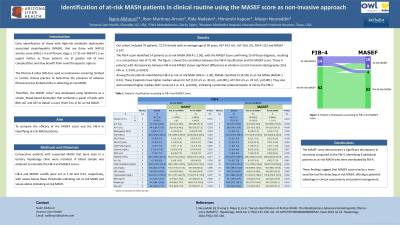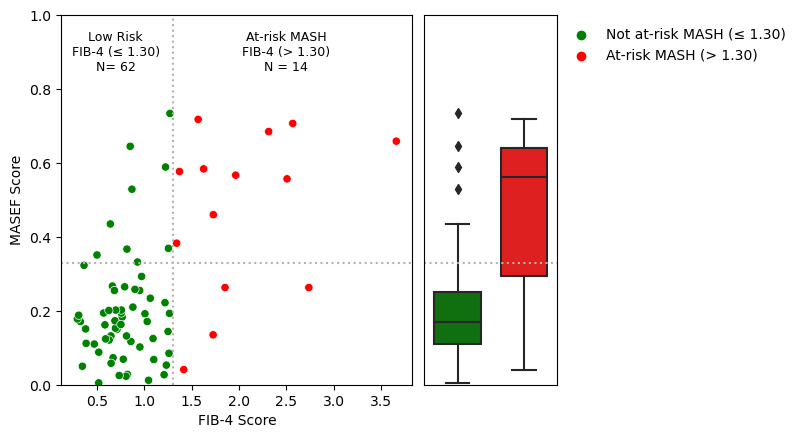Tuesday Poster Session
Category: Liver
P4644 - Identification of At-Risk MASH Patients in Clinical Routine Using the MASEF Score as Non-Invasive Approach
Tuesday, October 29, 2024
10:30 AM - 4:00 PM ET
Location: Exhibit Hall E

Has Audio
- NA
Naim Alkhouri, MD
Arizona Liver Health
Chandler, AZ
Presenting Author(s)
Naim Alkhouri, MD1, Ibon Martínez-Arranz, 2, Rida Nadeem, MD1, Himanshi Kapoor, BS1, Mazen Nouredden, MD, MHSc3
1Arizona Liver Health, Chandler, AZ; 2OWL Metabolomics, Derio, Pais Vasco, Spain; 3Houston Methodist Hospital, Houston, TX
Introduction: Early identification of those with high-risk metabolic dysfunction associated steatohepatitis (MASH), that are those with NAFLD activity score (NAS) ≥ 4 and fibrosis stage ≥ 2 (“at-risk MASH”) is an urgent matter, as these patients are at greater risk of liver complications and may benefit from novel therapeutic options. The Fibrosis-4 index (FIB-4) is used as noninvasive screening method in routine clinical practice to determine the presence of advance fibrosis but has limited utility in detecting at-risk MASH. Therefore, the MASEF score1 was developed using lipidomics as a simple, blood-based biomarker for at-risk MASH. This study aims to compare the efficacy of the MASEF score and the FIB-4 in identifying at-risk MASH patients.
Methods: Consecutive patients with suspected MASH that were seen in a tertiary hepatology clinic were included. A blood sample was obtained to calculate the FIB-4 and MASEF scores. FIB-4 and MASEF cutoffs were set at 1.30 and 0.33, respectively, with values below these thresholds indicating not at-risk MASH and values above indicating at-risk MASH.
Results: Our cohort included 76 patients, 72.1% female with an average age of 50 years, AST 34.5 U/L, ALT 50.6 U/L, FIB-4 1.02 and MASEF 0.247. The FIB-4 score identified 14 patients as at-risk MASH (FIB-4 ≥ 1.30), with the MASEF Score confirming 10 of those diagnosis, resulting in a concordance rate of 71.4%. The figure shows the correlation between the FIB-4 category and the MASEF score. Those 4 patients with discrepancies between FIB-4 and MASEF shown significant differences in vibration control transient elastography (10.6 kPa vs. 5.3 kPa, p=0.023). Among the 62 patients identified by FIB-4 as not at-risk MASH (FIB-4 < 1.30), MASEF classified 9 (14.5%) as at-risk MASH (MASEF ≥ 0.33). These 9 patients have higher median values for ALT (123 U/L vs. 30 U/L, p< 0.001), AST (54 U/L vs. 23 U/L, p< 0.001). They also demonstrated higher median FAST scores (0.2 vs. 0.5, p< 0.001), indicating a potential underestimation of risk by the FIB-4.
Discussion: The MASEF score demonstrates a significant discrepancy in sensitivity compared to the FIB-4, identifying additional patients as at-risk who were overlooked by FIB-4. These findings suggest that MASEF score may be a more sensitive tool for detecting at-risk MASH, offering a potential advantage in clinical assessments and patient management.
1Noureddin M, Truong E, Mayo R, et al. Hepatology. 2024;79(1):135-148.

Disclosures:
Naim Alkhouri, MD1, Ibon Martínez-Arranz, 2, Rida Nadeem, MD1, Himanshi Kapoor, BS1, Mazen Nouredden, MD, MHSc3. P4644 - Identification of At-Risk MASH Patients in Clinical Routine Using the MASEF Score as Non-Invasive Approach, ACG 2024 Annual Scientific Meeting Abstracts. Philadelphia, PA: American College of Gastroenterology.
1Arizona Liver Health, Chandler, AZ; 2OWL Metabolomics, Derio, Pais Vasco, Spain; 3Houston Methodist Hospital, Houston, TX
Introduction: Early identification of those with high-risk metabolic dysfunction associated steatohepatitis (MASH), that are those with NAFLD activity score (NAS) ≥ 4 and fibrosis stage ≥ 2 (“at-risk MASH”) is an urgent matter, as these patients are at greater risk of liver complications and may benefit from novel therapeutic options. The Fibrosis-4 index (FIB-4) is used as noninvasive screening method in routine clinical practice to determine the presence of advance fibrosis but has limited utility in detecting at-risk MASH. Therefore, the MASEF score1 was developed using lipidomics as a simple, blood-based biomarker for at-risk MASH. This study aims to compare the efficacy of the MASEF score and the FIB-4 in identifying at-risk MASH patients.
Methods: Consecutive patients with suspected MASH that were seen in a tertiary hepatology clinic were included. A blood sample was obtained to calculate the FIB-4 and MASEF scores. FIB-4 and MASEF cutoffs were set at 1.30 and 0.33, respectively, with values below these thresholds indicating not at-risk MASH and values above indicating at-risk MASH.
Results: Our cohort included 76 patients, 72.1% female with an average age of 50 years, AST 34.5 U/L, ALT 50.6 U/L, FIB-4 1.02 and MASEF 0.247. The FIB-4 score identified 14 patients as at-risk MASH (FIB-4 ≥ 1.30), with the MASEF Score confirming 10 of those diagnosis, resulting in a concordance rate of 71.4%. The figure shows the correlation between the FIB-4 category and the MASEF score. Those 4 patients with discrepancies between FIB-4 and MASEF shown significant differences in vibration control transient elastography (10.6 kPa vs. 5.3 kPa, p=0.023). Among the 62 patients identified by FIB-4 as not at-risk MASH (FIB-4 < 1.30), MASEF classified 9 (14.5%) as at-risk MASH (MASEF ≥ 0.33). These 9 patients have higher median values for ALT (123 U/L vs. 30 U/L, p< 0.001), AST (54 U/L vs. 23 U/L, p< 0.001). They also demonstrated higher median FAST scores (0.2 vs. 0.5, p< 0.001), indicating a potential underestimation of risk by the FIB-4.
Discussion: The MASEF score demonstrates a significant discrepancy in sensitivity compared to the FIB-4, identifying additional patients as at-risk who were overlooked by FIB-4. These findings suggest that MASEF score may be a more sensitive tool for detecting at-risk MASH, offering a potential advantage in clinical assessments and patient management.
1Noureddin M, Truong E, Mayo R, et al. Hepatology. 2024;79(1):135-148.

Figure: FIB-4 and MASEF score correlation in identifying at-risk MASH
Disclosures:
Naim Alkhouri: Altimmune, Chronwell ,Cytodyne,Madrigal Pharmaceuticals,Merck,Novo Nordisk,Rivus,Takeda,Terns – Consultant, Grant/Research Support.
Ibon Martínez-Arranz: OWL Metabolomics – Employee.
Rida Nadeem indicated no relevant financial relationships.
Himanshi Kapoor indicated no relevant financial relationships.
Mazen Nouredden: Altimmune – Advisor or Review Panel Member. Chronwell – Stock Options. Cytodyne – Stock Options. Madrigal Pharmaceuticals – Advisor or Review Panel Member, Consultant. Merck – Advisor or Review Panel Member. Novo Nordisk – Advisor or Review Panel Member. Rivus – Stock Options. Takeda – Advisor or Review Panel Member. Terns – Advisor or Review Panel Member.
Naim Alkhouri, MD1, Ibon Martínez-Arranz, 2, Rida Nadeem, MD1, Himanshi Kapoor, BS1, Mazen Nouredden, MD, MHSc3. P4644 - Identification of At-Risk MASH Patients in Clinical Routine Using the MASEF Score as Non-Invasive Approach, ACG 2024 Annual Scientific Meeting Abstracts. Philadelphia, PA: American College of Gastroenterology.
